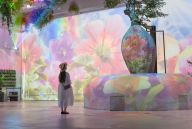Explore and Eat Your Way Around Tohoku with 1 Pass

Situated in the northern part of Japan mainland, Tohoku region consists of the Aomori, Iwate, Akita, Miyagi, Yamagata, and Fukushima prefectures. Natural wonders, local dishes cooked with seasonal ingredients, hot springs, and annual festivals are just some of the highlights of the region. To visit Tohoku and cover all the best spots in the area in one go, consider using the JR EAST PASS (Tohoku area). Here’s information about the pass and how to use it with two sample courses as reference.
About the JR EAST PASS (Tohoku area)
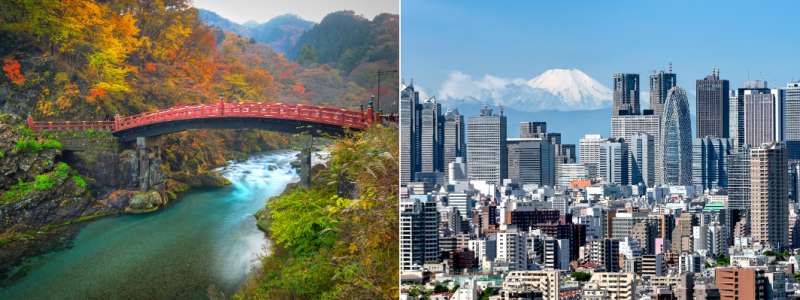
The pass allows unlimited rides on trains and bullet trains in the usage area of Tohoku for a period of five days within the 14-day validity period. Through the pass, you’ll get to see famous spots in Tohoku like Zao in the Yamagata and Miyagi prefectures; the shopping hub Akihabara in central Tokyo, restaurants and bars in Shinjuku City, shrines in Nikko; and popular sightseeing areas in Tokyo and some areas within Kanto. Depending on the train and route you take, a round-trip fare (for an adult) for reserved seats on the Tohoku Shinkansen (bullet train) between Tokyo Station and Sendai Station costs around ¥22,000. Using the JR EAST PASS (Tohoku area), the cost for the whole pass comes to just ¥20,360. Moreover, you can tour multiple prefectures and take advantage of unlimited rides on trains and buses in the area, so you can enjoy the Tohoku region at an excellent price!
Price
If purchased in Japan
Adults (12 years and older) ¥20,000
Children (6 - 11 years old) ¥10,000
Prices are subject to change.
Period
5 days of unlimited travel on trains and Shinkansen in the area covered!
※within 14-day period of validity
Usage Area [Railway companies and lines available for use]
・JR East (inc. BRT*), Tokyo Monorail, Izu Kyuko Line, Aoimori Railway Line
Iwate Galaxy Railway Line, Sendai Airport Line
※Reserved seats in ordinary cars of the following express trains with through operation between JR East and Tobu Railway lines: Nikko, Kinugawa, and SPACIA Kinugawa trains.
※You can also use ordinary trains (including rapid trains) on the Tobu Railway lines between Shimo-Imaichi and Tōbu Nikkō / Kinugawa Onsen.
Between Kurihashi and Shimo-Imaichi, you can only use express trains that have through operation with Tobu Railway.**
・JR buses in the area (excluding highway and some regular bus routes)
※BRT: bus rapid transit
※※You cannot use express trains that both depart from and terminate at stations on Tobu Railway lines.
You can only use the JR EAST PASS (Tohoku area) on Tobu Railway lines if the train either departs from or terminates at a JR station.
Use the JR EAST PASS (Tohoku area) to get around the region!
Recommended courses

(1) 3-day-2-night nature course
Day 1: Yamagata Zao & Sendai ! Enjoy sightseeing and hot springs!
Tokyo Station → Yonezawa Station → Zao → Yamagata Station → Stay over at Sendai

On the first day, we went sightseeing largely in the Zao area, which straddles the Miyagi and Yamagata prefectures. Zao’s attractions include the stunning Zao mountain range; the magnificent Okama crater lake, whose waters change to as many as five colors, depending on the sunlight; and Ice Monsters, a unique winter phenomenon of rime ice that forms in trees. Zao Onsen is also a must-visit: Dip into a communal bath for only ¥200! Sightseeing spots are found all over the area, so for efficiency, we recommend renting a car.
After buying souvenirs at Yamagata Station, we then headed to Sendai, where we feasted on the famous beef tongue for dinner. Inside the station, there’s a street known as Sendai Station Ushitan Dori, which has lots of restaurants to choose from. For dessert, try the Zunda Mochi, a sweetened mashed edamame rice cake.
Day 2: Iwate Ginga Railway! Enjoy the scenery from the train window & stop over in the Oirase area!
Sendai Station → Morioka Station (take the IGR Iwate Ginga Railway bound for Hachinohe) → Hachinohe → Shin-Aomori Station → stay over Oirase Onsen

On the second day, we went from Sendai to Morioka, and boarded the local line IGR Iwate Ginga Railway that departs from and arrives at Morioka. From the train window, the views of the mountains and plateau, as well as the countryside of woody Japan, were simply mesmerizing. After eating a seafood bowl in Hachinohe, we headed to Oirase Gorge, where we were healed by the sound of the clear water running in the deep forest! If you’re not used to walking on unpaved roads, there’s a trail for beginners. The season when the forest is a lush green is pretty, but we also highly recommend trips in autumn and winter.

Day 3: Enjoy the “Gono Line"! Head to the popular Shirakami-Sanchi area
Oirase Onsen → Shin-Aomori Station → Kawabe Station (Take the JR Gono Line bound for Fukaura) → Akitashirakami Station → Shirakami-Sanchi
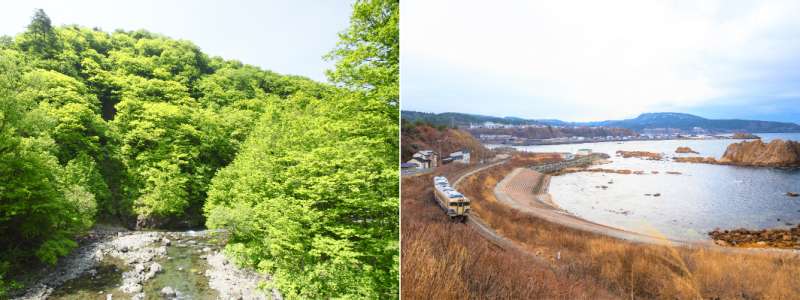
On the third day, after enjoying a stroll around Oirase Onsen, we took the JR Gono Line and headed to the Shirakami-Sanchi, a UNESCO World Heritage Site in one of the world's most prominent primeval forests. The JR Gono Line is a local train line that connects Akita and Aomori, and is also known for its spectacular views along the Sea of Japan.
(2) Samurai spot tour course 3 days 2 nights recommended course!
Day 1: Take a walk through the historic cityscape of Aizu-Wakamatsu! Stay at Higashiyama Onsen
Tokyo Station → Koriyama Station → Aizu-Wakamatsu Station → stay over at Higashiyama Onsen

On the first day, we took a three-hour ride on the Tohoku Shinkansen from Tokyo Station en route to the Tohoku region. We first headed to Aizu-Wakamatsu, a castle town in Fukushima Prefecture, and home to the historical Tsuruga Castle and Mt. Iimori. For lunch, we had Aizu-Wakamatsu's affordable local dish, Sauce Katsudon, a deep-fried breaded pork with Worcestershire sauce!

Aizu-Wakamatsu is also famous for its sake, so we recommend touring a sake brewery and purchasing souvenirs. Our accommodations were at Higashiyama Onsen, about 20 minutes by car from Aizu-Wakamatsu. Aizu-Wakamatsu is gorgeous any time of the year. Catch the cherry blossom season in spring, enjoy lush greenery in early summer, see the leaves change color in autumn, and relax in a warm bath with a view of snow in winter.
Day 2: Sightseeing in Yamagata's famous temple "Yamadera"! Overnight at Tendo Onsen
Higashiyama Onsen → Yamagata Station → Yamadera Station → JR Tendo Station → stay over at Tendo Onsen
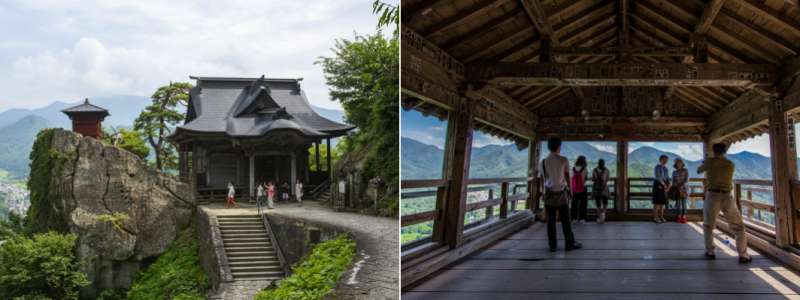
On our second day, we decided to head to Yamagata Station first. After strolling around Kajo Park, which is easy to access from the station and is famous for its cherry blossoms, we moved to the famous Yamadera Temple, also known by its official name, Tateishi Temple. We also went to Nemoto Chudo, which is considered to be the oldest beechwood building in Japan and has been designated as a National Important Cultural Property. Nature can be enjoyed on a trail stretching about an hour to Okunoin, where the Great Buddha Hall is situated. After a long day, we spent the night at Tendo Onsen. Tendo City is famous as a production center for Shogi (a traditional Japanese board game) pieces. There are Shogi pieces all over the city, and there are even manholes with illustrations of Shogi pieces! Do make the most of the unique townscape.
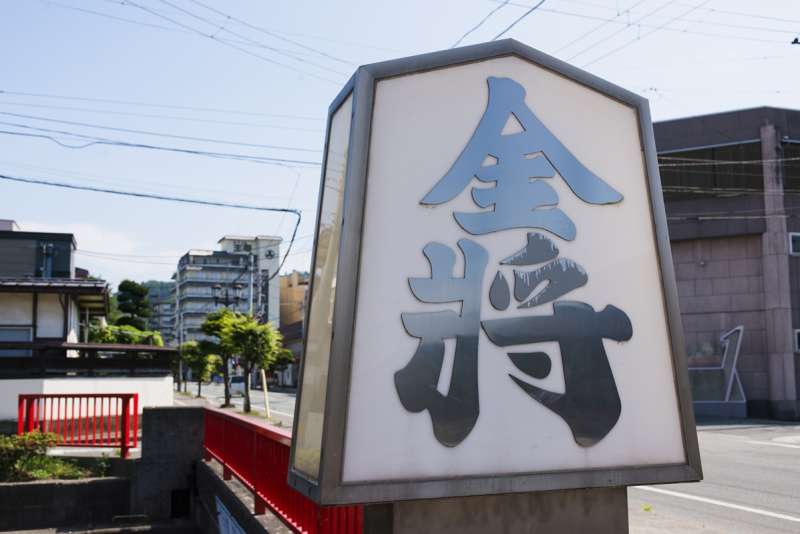
Day 3: On the final day, take a stroll around the samurai residence street in Kakunodate!
Tendo Onsen → JR Tendo Station → JR Kakunodate Station → JR Morioka Station
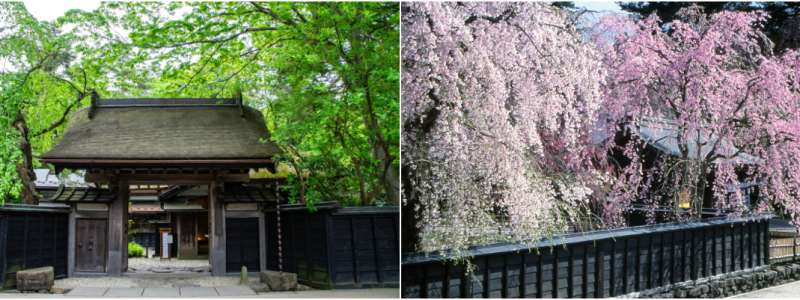
The castle town of Kakunodate features samurai residences (left) and cherry blossoms (right).
On the third day, we went to Kakunodate in Akita Prefecture. An area that once prospered as a castle town, it is famous for its samurai residences and rows of cherry blossom trees in the spring, and is also known as Little Kyoto of Michinoku (the former name of the Tohoku region). Note the retro cafes and restaurants as you take a leisurely stroll around the city. We recommend renting and wearing a kimono for a day and taking photos with a samurai residence in the background! When heading back to Tokyo, we ate Wanko soba(a server puts a mouthful of soba into each customer's bowl, and as they finish eating, the waiter adds more soba) and Morioka Reimen(spicy cold noodles), local dishes that are served at places around Morioka Station. Don’t leave without souvenir-shopping!
Refer to the following for more information on the facilities mentioned in this article.
https://www.japan.travel/en/destinations/tohoku/
https://www.tohokukanko.jp/en/index.html
https://www.jreast.co.jp/e/eastpass_t/index.html?src=gnavi
About Tohoku Trains in Winter
https://www.japan.travel/en/my/your-first-winter-japan/enjoy-natural-snow-scenery-tohoku-trains/
https://www.japan.travel/en/my/fascinating-suburb-japan/ride-tohoku-specialty-local-line-gono-line/















































